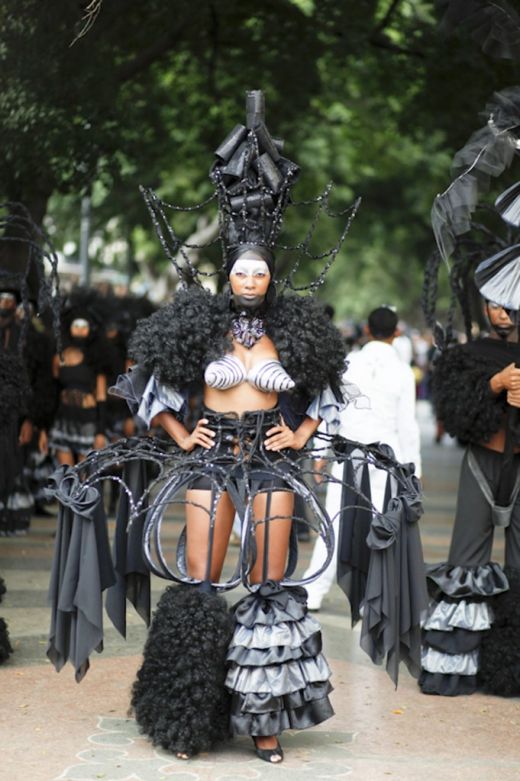
Los Carpinteros, “Conga Irreversible,” 2012. XI Bienal de La Habana. Photography: Ignacio Barrios © Los Carpinteros Courtesy: Sean Kelly Gallery, New York.
This is what I think is happening there. When the Non-Aligned Movement (NAM) was founded in 1961 by the beloved ex-Yugoslavia dictator Tito and his peers, the Cold War was at its peak and the Bay of Pigs was just around the corner. However, 50 years later, the very existence of this international organization sounds like a remote past, especially in Havana, the same city that was one of NAM’s Latin American headquarters. Even though we have seen a recent resurgence of leftist movements supposedly aligned with the so-called civil rights movements of the 1960s, these movements are now quickly dissolving. It is also the case that they are rarely seriously considered. Take Chavez’s overdue revolution in Venezuela and its Latin American copycat counterparts, whose intentions look a lot more like those of the old fashioned 19th century caudillos trying to stay in power as long as they can, not to mention the precise resemblance they have to the stereotypical banana republic.
Despite its current membership of 120 countries, the glory days of the NAM are over, and the anti-imperialist jargon is just short of caricature in a globalized world subject to the power of late capitalist biased mass media. In contrast, the mere idea of an international art elite jetsetting to Havana for the 2012 Biennial brings certain nostalgia for those days of bucolic ideological battles. On the opposite end, the Cuban government has found a Caribbean realpolitik—a way to stay in power, even at the expense of a country nowadays considered a tourist attraction.
So, why are we still thinking in these nostalgic terms in relation to the Havana Biennial? Let’s go through a quick overview of the biennial’s international press coverage to see this picture through the eyes of others. In an article published in Domus magazine, it is said that “Today, after a number of decades of extreme closure, Cuba is embarking, albeit slowly and cautiously, on the road to change. The 11th Havana Biennial reflects this prudent but evident process and seems to mark a real transition.” Between the lines, it’s quite obvious to me that the author of this article thinks that the cold war imagery is still prevalent on the “Island,” that the current openness could lead to a closure from the government, as so many people had it in their minds in Havana this summer.
Let’s see what the New York Times has to say about the biennial, aside from the most abused cliché, that bringing international artists to Havana “opens our horizons.” In “American Accents Being Heard on the Malecón,” journalist Victoria Burnett writes that “on the fringes of the biennial, groups of connoisseurs, many of them American, were shuttling among galleries and studios, meeting with artists and snapping up work. Artists occupy an unusual and privileged place in Cuba, where they can not only push the boundaries of political critique further than many, but can also keep much of the money from sales.”
This can be interpreted as a way of saying that artists are being favored by the Cuban government over the other 99.99 percent of the population. I’m not alone in thinking that there is an unavoidable and nostalgic drive that informs the perception of what the Havana Biennial means. This is caused by many people thinking of Cuba as the perfect ideological other in a system that pits the right against the left.
In a dialectical way, this extemporaneous nostalgia for the Cold War on the part of the international art elite is surprising, especially considering the skepticism that surrounds the biennial. On the other hand, the Havana Biennial makes it clear that in art jargon, everything can be said. Perhaps there was a time when the Cold War was the universal measure against which distinctions were made. Perhaps that’s why, from a Latin American point of view, it was impossible to see the relationship between Russian Constructivism and North American Minimalism. (How can an artist represented by a mainstream New York gallery be related to anything but consumerism, capitalism and imperialism?) In those days, the difference between a Che Guevara poster and a cube shaped out of industrial materials was very clear. Now if you go to a gallery in Chelsea you would find more or less the same list of artists that took part in the Havana Biennial. Today, some performances that you see in New York—Occupy Wall Street, for one—can be widely considered more politically radical than any of the works in this or any other cutting-edge biennial. This is why I am so curious about how a cold war mentality stills prevails, even though it is no longer operative in reality.
I think it is good idea to understand the current Havana Biennial according to cold war jargon. Our paranoid society, with the public sphere almost under complete control by an ever-diversified surveillance system, is a direct consequence of the Cold War and all its infinite gadgets. So maybe art has the ability to explain why, if ideology is dead, all of its byproducts are still very alive.










